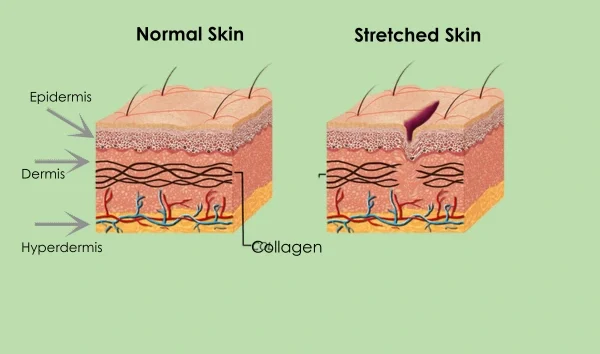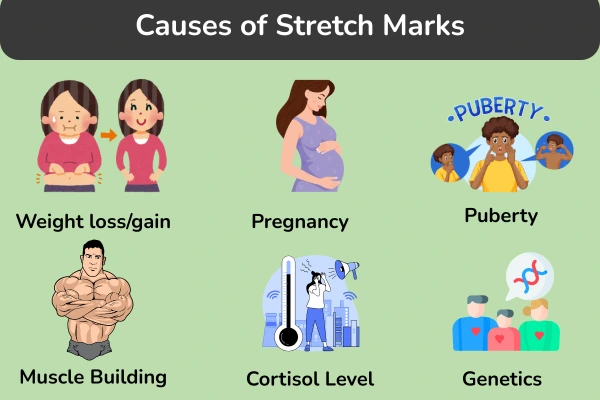Up to 25% OFF on Selected Treatments
-
Treatments
Acne and Scar
Pigmentation
Laser Hair Reduction
Dermato-surgery
Body
Anti Aging
Skin Rejuvenation
Others
- Clinics
- Blogs
Treatments
Are you experiencing stretch marks on your body and feeling stressed and a little down? These indented streaks or reddish-purple lines can appear on any part of the body, including buttocks, due to various factors, causing aesthetic concerns for many. But fear not! This informative guide will help you understand what are stretch marks actually and what cause stretch marks on buttocks, effective treatments, and preventive tips that help manage and get rid of stretch marks on the buttocks.
Stretch marks, medically known as striae, are long, narrow streaks or lines that develop when the skin stretches or shrinks rapidly. This disrupts collagen and elastin production, the proteins responsible for skin elasticity and structure. As a result, the underlying connective tissue shows through the dermis (the middle layer of skin), causing those indented lines.
They initially appear as red, purple, pink, or dark brown lines, and over time, they fade to a lighter, silvery, or white color. Although stretch marks can occur anywhere on the body, they are particularly common on the abdomen, thighs, hips, breasts, upper arms, and buttocks. They are not painful, but they can be a source of self-consciousness for many people.

Several factors contribute to the development of stretch marks on your buttocks. Here are some of the most common causes:

The stretch marks are often seen on the buttocks because this area is susceptible to rapid skin stretching. What causes stretch marks on buttocks include multiple reasons, that includes rapid weight gain of loss, vigorous strength training and exercise, hormonal changes as a result of pregnancy or puberty, and genetics. The buttocks can be considered a common area to develop stretch marks due to the tension in the skin and decreased elasticity.
Stretch marks are not painful or harmful, but many people dislike having them. It can’t be erased entirely, but its appearance can be reduced significantly with proper dermatological care. There are many topical creams and natural remedies available to get rid of stretch marks, but it is a time-consuming process. If you are looking for an option to get rid of stretch marks on butt, it is best to choose professional treatments from dermatologists. While eliminating stretch marks may not be possible, several professional treatments offered by the Evenly Clinic can significantly reduce their appearance. Here’s how to get rid of stretch marks on the buttocks:
Certain creams and lotions containing ingredients like tretinoin (a vitamin A derivative), hyaluronic acid, and Centella asiatica may help improve the appearance of stretch marks. These work by stimulating collagen production and increasing skin hydration. However, the effectiveness of topical treatments can vary, and consistent use is often necessary to see results.
Laser treatments can be used to address stretch marks on the buttocks. Advanced lasers available at Evenly Clinic, Bangalore, target the damaged skin tissue, stimulating collagen production and promoting a smoother appearance. While laser treatments can be effective, they may require multiple sessions and can be expensive.
Must Read: Why Laser Treatment for Stretch Mark Removal: How it works & What to Expect
This minimally invasive treatment involves using a microneedling device to create tiny punctures in the skin while simultaneously delivering radio frequency energy. This controlled injury with heat energy reaches deeper layers of the skin, stimulates collagen production, and tightens the underlying tissue.
Note for Bangalore’s Skin Conditions: Due to the high humidity and variable climate in Bangalore, skin tends to become more reactive. This can make stretch marks appear darker or more prominent. Treatments like MNRF and lasers work well in such cases.
Chemical peels can be used to improve the appearance of stretch marks by removing the outer layer of skin and stimulating new cell growth. However, chemical peels are not as effective for stretch marks compared to other areas of concern, like wrinkles.
Important Note: It is crucial to consult with a dermatologist before undergoing any treatment for stretch marks on the buttocks. They can assess your situation, recommend the most suitable treatment option, and discuss potential side effects.
If you are searching for stretch mark treatment in Bangalore, trust Evenly Clinic to offer advanced dermatological solutions tailored to your needs. Visit Evenly Clinic and get rid of stretch marks easily and safely. Schedule an appointment at Evenly and reduce the appearance of stretch marks gradually. Our clinic is equipped with USFDA-approved equipment and board-certified dermatologists who specialize in managing stretch marks common among young mothers.
If you are wondering what are stretch marks, they are common skin condition specially in buttocks that result from the tearing of the dermis during periods of rapid body change. By understanding their causes, knowing how to get rid of stretch marks on the buttocks, and taking preventive measures like maintaining a healthy weight, staying hydrated, and eating a balanced diet, you can minimise your risk of developing them. With various treatment options available, including topical treatments, laser treatments, MNRF, and more, it’s possible to reduce their appearance.
ಬಟಕ್ಸ್ ಮೇಲೆ ಸ್ಟ್ರೆಚ್ ಮಾರ್ಕ್ಗಳು ನಿಮಗೆ ತೊಂದರೆ ನೀಡುತ್ತಿದೆಯಾ? ಈ ಸಮಸ್ಯೆಗೆ ಈಗ Bangalore ನಲ್ಲಿ ಉತ್ತಮ ಪರಿಹಾರಗಳಿವೆ. ಈಗಲೇ Evenly Clinic ಅನ್ನು ಸಂಪರ್ಕಿಸಿ – 90197 37474, 96069 77090
Visit us at:
Evenly Skin and Hair Clinic – HSR Layout
Third Floor, 815, 27th Main Rd, above Bluestone, 1st Sector, HSR Layout, Bengaluru, Karnataka 560102
Evenly Skin and Hair Clinic – Jayanagar
35, Ground Floor, Vinyas Arcade, 11th Main Rd, Vishya Bank Colony, 5th Block, Jayanagar, Bengaluru, Karnataka 560041
For health-related information, follow us on Instagram!!
Can certain types of clothing cause stretch marks on the buttocks?
Tight-fitting clothing that constantly rubs against the skin can irritate it, but there’s no direct link between clothing and stretch mark formation. However, wearing comfortable, breathable clothes that don’t restrict movement is essential for overall skin health.
Can we completely get rid of stretch marks on the buttocks?
Eliminating stretch marks is not possible, but their appearance can be significantly reduced with treatments such as topical creams, laser treatment, micro-needling, and radio frequency.
Is MNRF effective for treating stretch marks on the buttocks?
Yes, microneedling and radio frequency involve using fine needles and radio frequency to create micro-injuries in the skin, stimulating collagen and elastin production, which can improve the appearance of stretch marks.
Can men get stretch marks on their buttocks too?
Yes, men can develop stretch marks on their buttocks due to factors such as rapid weight gain or loss, bodybuilding, and hormonal changes during puberty. The causes and treatments for men are similar to those for women.
Are there any side effects to treatments for stretch marks on the buttocks?
Some treatments, like laser treatment, MNRF, and chemical peels, may have side effects such as redness, swelling, and temporary skin irritation. It’s essential to consult with a dermatologist to understand the potential risks and benefits of each treatment.
We hope this information has been helpful. If you have any skin and hair-related questions or would like to discuss personalized solutions, please reach out to us at 7337899030. Our team of experts is dedicated to providing personalized care that meets your unique needs. Take the first step towards a healthier, more confident you by scheduling a consultation with us today. Your journey to vibrant skin and stronger hair begins here.
Book an Appointment
Start your journey to healthy skin and hair today.
Leave a Comment